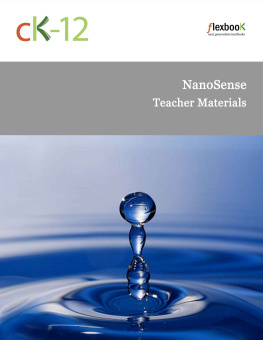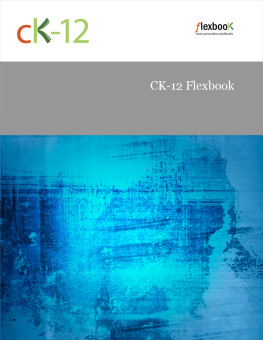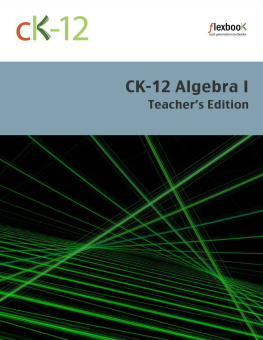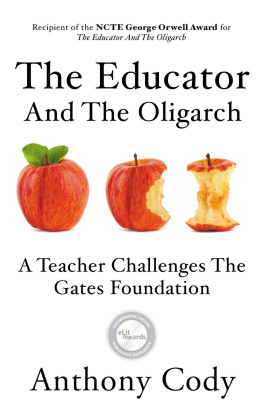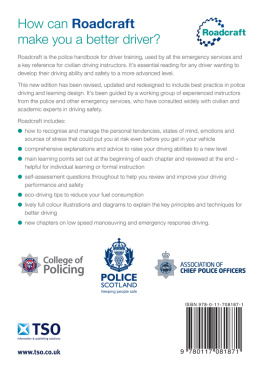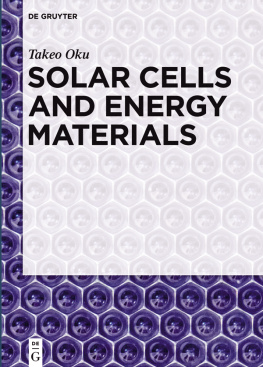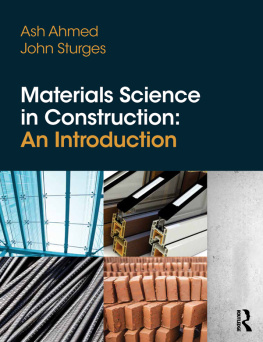CK-12 Foundation - NanoSense Teacher Materials
Here you can read online CK-12 Foundation - NanoSense Teacher Materials full text of the book (entire story) in english for free. Download pdf and epub, get meaning, cover and reviews about this ebook. genre: Children. Description of the work, (preface) as well as reviews are available. Best literature library LitArk.com created for fans of good reading and offers a wide selection of genres:
Romance novel
Science fiction
Adventure
Detective
Science
History
Home and family
Prose
Art
Politics
Computer
Non-fiction
Religion
Business
Children
Humor
Choose a favorite category and find really read worthwhile books. Enjoy immersion in the world of imagination, feel the emotions of the characters or learn something new for yourself, make an fascinating discovery.
- Book:NanoSense Teacher Materials
- Author:
- Genre:
- Rating:4 / 5
- Favourites:Add to favourites
- Your mark:
- 80
- 1
- 2
- 3
- 4
- 5
NanoSense Teacher Materials: summary, description and annotation
We offer to read an annotation, description, summary or preface (depends on what the author of the book "NanoSense Teacher Materials" wrote himself). If you haven't found the necessary information about the book — write in the comments, we will try to find it.
NanoSense Teacher Materials — read online for free the complete book (whole text) full work
Below is the text of the book, divided by pages. System saving the place of the last page read, allows you to conveniently read the book "NanoSense Teacher Materials" online for free, without having to search again every time where you left off. Put a bookmark, and you can go to the page where you finished reading at any time.
Font size:
Interval:
Bookmark:
To access a customizable version of this book, as well as other interactive content, visit www.ck12.org
CK-12 Foundation is a non-profit organization with a mission to reduce the cost of textbook materials for the K-12 market both in the U.S. and worldwide. Using an open-content, web-based collaborative model termed the FlexBook. CK-12 intends to pioneer the generation and distribution of high-quality educational content that will serve both as core text as well as provide an adaptive environment for learning, powered through the FlexBook Platform.
Copyright 2012 CK-12 Foundation, www.ck12.org
The names "CK-12" and "CK12" and associated logos and the terms "FlexBook" and "FlexBook Platform" (collectively "CK-12 Marks") are trademarks and service marks of CK-12 Foundation and are protected by federal, state, and international laws.
Any form of reproduction of this book in any format or medium, in whole or in sections must include the referral attribution link http://www.ck12.org/saythanks (placed in a visible location) in addition to the following terms.
Except as otherwise noted, all CK-12 Content (including CK-12 Curriculum Material) is made available to Users in accordance with the Creative Commons Attribution/Non-Commercial/Share Alike 3.0 Unported (CC BY-NC-SA) License (http://creativecommons.org/licenses/by-nc-sa/3.0/), as amended and updated by Creative Commons from time to time (the "CC License"), which is incorporated herein by this reference.
Complete terms can be found at http://www.ck12.org/terms.
ISBN :978-1-935983-62-0

Authors
Patricia Schank, Tina Stanford
Website
http://nanosense.org/
Say Thanks to Authors
Click http://ck12.org/saythanks
(No Sign in required)
Contents
- For Anyone Planning to Teach Nanoscience...Read This First!
- Size Matters Overview and Learning Goals
- Unit at a Glance: Suggested Sequencing of Activities by Day for the Full Set of Size Matters Curriculum Materials
- Alignment of Unit Activities with Learning Goals
- Alignment of Unit Activities with Curriculum Topics
- Alignment Chart: Key Knowledge and Skills
- (Optional) Size Matters Pretest/Posttest: Teacher Answer Sheet
Nanoscience Defined
Nanoscience is the name given to the wide range of interdisciplinary science that is exploring the special phenomena that occur when objects are of a size between  and
and  in at least one dimension. This work is on the cutting edge of scientific research and is expanding the limits of our collective scientific knowledge.
in at least one dimension. This work is on the cutting edge of scientific research and is expanding the limits of our collective scientific knowledge.
Nanoscience is Science-in-the-Making
Introducing students to nanoscience is an exciting opportunity to help them experience science in the making and deepen their understanding of the nature of science. Teaching nanoscience provides opportunities for teachers to:
- Model the process scientists use when confronted with new phenomena
- Address the use of models and concepts as scientific tools for describing and predicting chemical behavior
- Involve students in exploring the nature of knowing: how we know what we know, the process of generating scientific explanations, and its inherent limitations
- Engage and value our student knowledge beyond the area of chemistry, creating interdisciplinary connections
One of the keys to helping students experience science in action as an empowering and energizing experience and not an exercise in frustration is to take what may seem like challenges of teaching nanoscience and turn them into constructive opportunities to model the scientific process. We can also create an active student-teacher learning community to model the important process of working collaboratively in an emerging area of science.
This document outlines some of the challenges you may face as a teacher of nanoscience and describes strategies for turning these challenges into opportunities to help students learn about and experience science in action. The final page is a summary chart for quick reference.
Challenges & Opportunities
1. You will not be able to know all the answers to student (and possibly your own) questions ahead of time...
Nanoscience is new to all of us as science teachers. We can (and definitely should) prepare ahead of time using the resources provided in this curriculum as well as any others we can find on our own. However, it would be an impossible task to expect any of us to become experts in a new area in such a short period of time or to anticipate and prepare for all of the questions that students will ask.
...This provides an opportunity to model the process scientists use when confronted with new phenomena .
Since there is no way for us to become all-knowing experts in this new area, our role is analogous to the lead explorer in a team working to understand a very new area of science. This means that it is okay (and necessary) to acknowledge that we dont have all the answers. We can then embrace this situation to help all of our students get involved in generating and researching their own questions. This is a very important part of the scientific process that needs to occur before anyone steps foot in a lab. Each time we teach nanoscience, we will know more, feel more comfortable with the process for investigating what we dont know, and find that there is always more to learn.
One strategy that we can use in the classroom is to create a dedicated space for collecting questions. This can be a space on the board, on butcher paper on the wall, a question box or even an online space if we are so inclined. When students have questions, or questions arise during class, we can add them to the list. Students can be invited to choose questions to research and share with the group, we can research some questions ourselves, and the class can even try to contact a nanoscientist to help us address some of the questions. This can help students learn that conducting a literature review to find out what is already known is an important part of the scientific process.
2. Traditional chemistry and physics concepts may not be applicable at the nanoscale level...
One way in which both students and teachers try to deal with phenomena we dont understand is to go back to basic principles and use them to try to figure out what is going on. This is a great strategy as long as we are using principles and concepts that are appropriate for the given situation.
However, an exciting but challenging aspect of nanoscience is that matter acts differently when the particles are nanosized. This means that many of the macro-level chemistry and physics concepts that we are used to using (and upon which our instincts are based) may not apply. For example, students often want to apply principles of classical physics to describe the motion of nanosized objects, but at this level, we know that quantum mechanical descriptions are needed. In other situations it may not even be clear if the macroscale-level explanations are or are not applicable. For example, scientists are still exploring whether the models used to describe friction at the macroscale are useful in predicting behavior at the nanoscale (Luan & Robbins, 2005).
Next pageFont size:
Interval:
Bookmark:
Similar books «NanoSense Teacher Materials»
Look at similar books to NanoSense Teacher Materials. We have selected literature similar in name and meaning in the hope of providing readers with more options to find new, interesting, not yet read works.
Discussion, reviews of the book NanoSense Teacher Materials and just readers' own opinions. Leave your comments, write what you think about the work, its meaning or the main characters. Specify what exactly you liked and what you didn't like, and why you think so.

